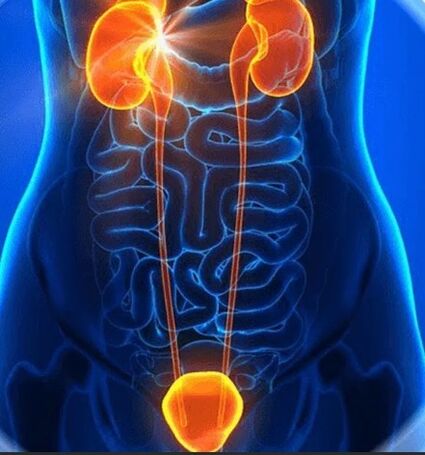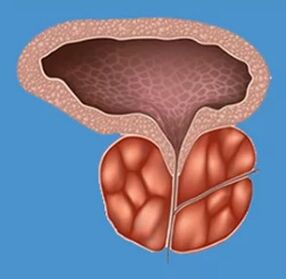Most of us got used to this to carefully check the health of our hearts and we need to worry about the health of the lungs.But few people remember that the "second heart" - the prostate gland - requires special care.
This is a small organ, the size of the nuts.Not everyone knows where they are and what they intend to do.But he is often one of the most important reasons for health problems in the male half of mankind.In fact, troubles can go beyond a teenager and an elderly akakala.
Like all other diseases, inflammation of the prostate - the most common disease in the prostate - can be prevented more easily than treatment, and early treatment can be treated more easily than in later stages.Therefore, it is extremely important for all people to know the symptoms of the disease in order to contact a urologist on time.

The prostate or prostate is a muscle -packed organ that is an integral part of a person's sexual system.Located in a small pool, only approx.20-30 grams.The main function of the prostate when a simplified language is spoken, is the production of a liquid that is part of the sperm.
Despite its modest size (a small chestnut size), this little piece of iron can defeat Hercules.
According to the World Health Organization, one in three people of Europe and the United States noticed the symptoms of inflammation of the prostate gland at least once.One in five people have chronic prostatitis.
Adenom prostate, which is similar to prostatitis, is detected in 10-15% of men over 50 years of age.Young men, especially chronic forms, especially chronic forms, are particularly disturbed in young men, especially in chronic forms.
It is easy to obtain prostate inflammation, but this is treated for many years.
Urologists and andrologists - doctors treating prostatitis - are often referred to as a "quiet disease" because it cannot report its existence at first.When this disease is noticed, we usually talk about complications of inflammation of the prostate gland.
Each patient is distinguished by their own special process of the disease and the causes of its occurrence.
Causes of prostatitis
Prostatitis is inflammation of the prostate gland.The main cause of the disease is stagnation of pelvis blood.You can provoke the disorders of the stomach tract, which are manifested in the form of frequent constipation and intestinal disorders.Among other reasons:
- violation of the immune system;
- other infectious diseases that are sexually transmitted;
- circulatory failure in the penis;
- irregular sex life;
- Neuroendocrine disorders in the body.
Symptoms of prostatitis
Typical symptoms of inflammation of the prostate gland are disorders of the urine system.The reason for this is that, in the case of inflammation, the size of the prostate increases and begins to squeeze it with the urethra.In the absence of treatment, the inflammatory process causes sclerosis of the bladder neck and, in the case of more severe development, the urethra can be completely blocked.
The second important feature is the disorder of sexual function.This is manifested in the form of a weakening of the erection, the poor severity of the orgasm.As a result, impotence and infertility develop.
Other typical signs of prostatitis:
- burning sensation in the toe and urethra (urethra);
- discomfort in prostate and urine during bowel movements (emptying);
- intensity of increased and increased urination;
- difficulty and period of urination;
- emptying from the urethra of the intestinal walls;
- Floating "fibers" are noticeable in the urine;
- At night, long inexplicable receptors are observed;
- Acceleration of ejaculation during intercourse;
- Deleted orgasm;
- increasing overall fatigue;
- depressed, anxious condition, mental depression with prediction of complications;
- Deterioration of erection.

Not all the symptoms listed can be observed immediately.Therefore, do not wait for the entire "bouquet" - as soon as you have noticed the symptoms described above - go to a specialist immediately.Do not consult your friends or act on your own, as everyone has their own symptoms and treating their own illnesses.
Other signs may appear over time.Appear:
- pain of painful nature at the bottom of the penis root;
- pain in the scrotum region;
- Pain in the perineum.
Doctors include infertility in which spermatosoids produce but lose their mobility in subsequent symptoms.
Strengthening sore pains may indicate that stones have developed in the prostate gland.It is much harder to get rid of them than the kidney stone or even the gallbladder.When they are detected, the doctor can only slow down his or her education in the future and increase existing ones.
The urologist is often dealt with in stages when prostatitis also affects the work of other organs and systems.In this case, other professionals should be involved in the treatment.
Who risk prostatitis?
Risk groups are men who:

- lead a sedentary lifestyle;
- Representatives of the professions, where 8 or more hours have to sit in a row;
- which have chronic constipation;
- handed over infectious diseases of the geniturinary system;
- Do not have a regular sex life;
- Living a random sex life;
- the suffering of alcoholism.
Diagnosis of inflammation of the prostate gland
Diagnosis is made to accurately determine the stage of the disease and proper treatment, including the following:
- clinical examination;
- blood test;
- urine analysis;
- Analysis of prostate secretion;
- Ultrasound;
- Uroflowmetry.
What drugs are treated?
At the end of the diagnostic examination, doctors usually prescribe complex treatment, including the following:
- treatment of the immune system;
- Treatment of infections, if any, usually - with antibiotics;
- Antibacterial drugs used to treat precise diseases of the prostate.

Various physiotherapy procedures are used to treat prostatitis, such as:
- massage;
- Magnetosinonance therapy;
- laser treatment;
- reflexology;
- ultrasound;
- Hirudotherapy.
To prevent and diagnose prostatitis
Every person under the age of 40 is simply mandatory to maintain their health every year to examine a urologist.After 40, this must be done once every six months.
Over time, the healing or advanced inflammation of the prostate gland can lead to many complications listed above, which can seriously complicate your life and not just sexual.
The main preventive measure is, of course, the banal leadership of a healthy lifestyle.Because blood stagnation in the pelvic organs is one of the most common causes of the disease, compensation for sedentary and inactive work should be compensated by physical exercises and outdoor activities with all power.
It is important to avoid hypothermia and to perform regular sex life.
































